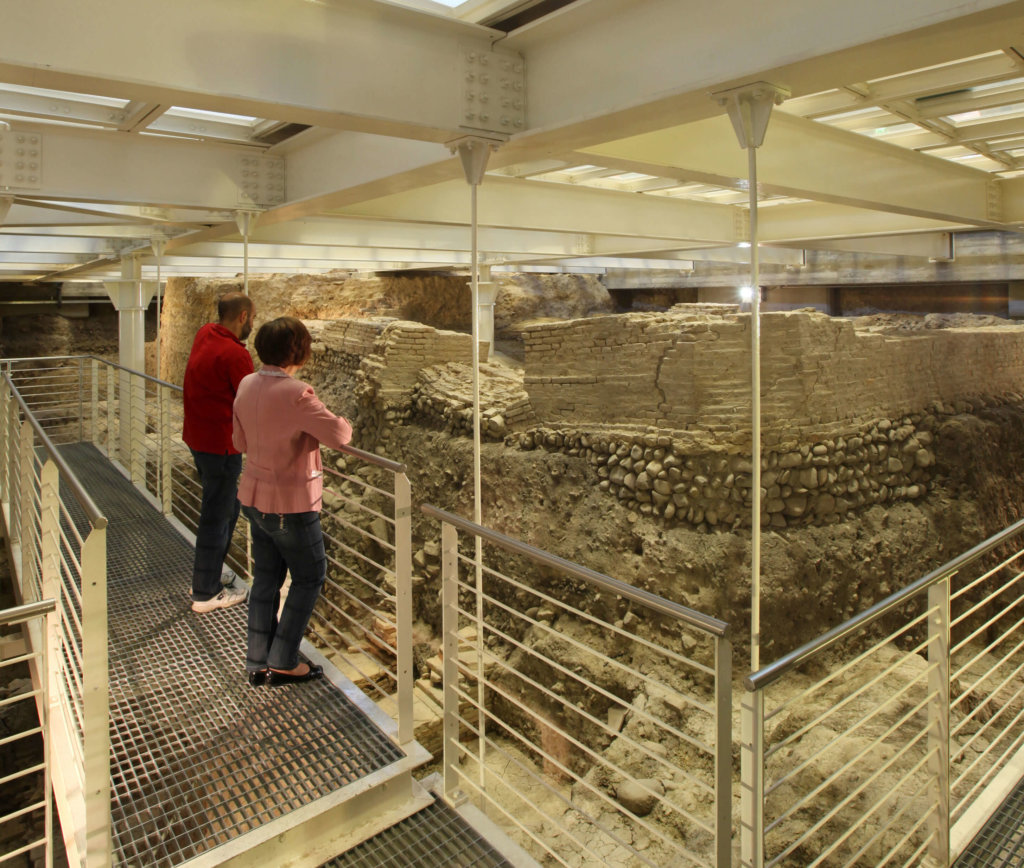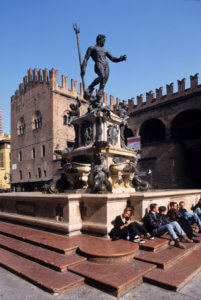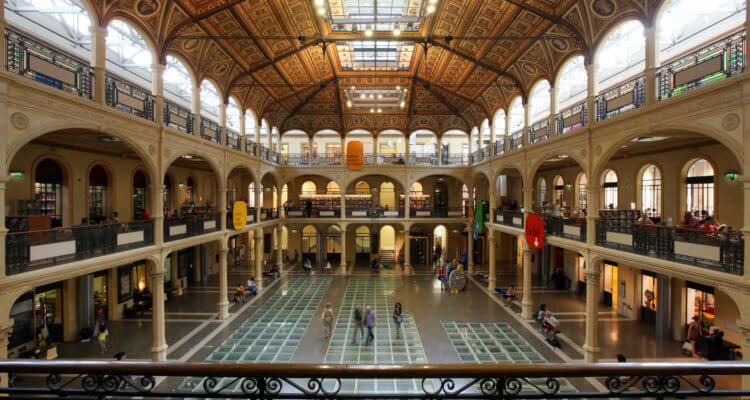It’s not often you have to consider your attire to attend a public library. But you may want to do just that before visiting the principal library in this ancient city in north central Italy. Palazzo d’Accursio, the ancient and historical seat of the city government, provides a rich and fascinating cultural space for Salaborsa.
The main floor in this modern library is made of glass. You can look down through the glass at the ruins of the building that stood on this same site 2,000 years before Christ walked the earth. The ruins are still being excavated and there are archaeological students and tourists working and walking amidst the ruins below your feet. When these people look up, they get a spectacular view of the soaring four-story atrium topped by the glass roof of the library. They can also get a work-stopping view straight up your skirt if you’re so attired. And there is no shortage of short skirts in this town.

Bologna has a population of 330,000, which includes 150,000 students from around the world. But, despite its high ratio of students, this city is considered the most affluent in Italy. Its streets are lined with trendy fashion and jewelry shops and expensive cars. Mind you, the cars in Bologna are outnumbered 12-to-1 by scooters. The cascading steps of the principal library flow down to Bologna’s central piazza, occupied by a huge bronze statue of Neptune, god of the sea. The voluptuous mermaids surrounding Neptune have breasts that spew water, which the locals freely drink.
One reason this city is overrun with students – foreign and domestic – is that it is the seat of higher education in Europe. The first public university in the world was established here more than 900 years ago by the Roman Catholic Church, but it wasn’t necessarily created to impart greater knowledge to the multitudes. University of Bologna was created to stop the growth of a huge church that was challenging St. Peter’s Basilica in Rome. Bologna’s Basilica di San Petronio is today the fifth largest church in the world. It was planned to be larger than St. Peter’s, the Pope’s church in Rome, and that just wouldn’t do. Bologna got the word to stop. It’s a huge church, but walk around to the rear exterior and you can see where construction abruptly stopped centuries ago. To keep the church from expanding, Rome established a university right beside it. The walls and ceilings of both the church and the university are filled with magnificent frescoes. There is free entry to both, but be prepared to be frisked before entering the basilica. There is heavy security at the entrance to the church because of a painting inside. It’s not the value of the painting – although that is substantial – it’s the content. The artist depicts heaven and hell in the large fresco and among the suffering souls in hell is Mohammed. This enrages and insults devout Muslims and there have been many threats against the fresco and the church itself – thus the heavy security. Inside the basilica, the ceiling soars 41 meters (135 feet) high. The main interior nave is 132 meters (433 feet) long. The basilica faces out onto Piazza Maggiore, the largest and busiest piazza in the city, which was created in 1200. If you sit at one of the various cafes in the piazza for a day or two you’ll likely see most of the locals stroll by.


Neptune has his own piazza, just off this principal piazza where many young people start their evening dates by meeting on Neptune’s steps. You won’t need to roam far from Neptune and his neighboring Piazza Maggiore to see most of the historic and ancient attractions of Bologna. The city hall, built in 1287, was once ruled over by a mayor who quit politics to become a Catholic priest and eventually became Pope Gregory XIII. He gave us today’s Gregorian calendar.
You can do most of your roaming protected from rain, snow or a hot blazing sun. This city has more than 40 kilometers (25 miles) of porticos – covered walkways – in its core. One stretch of fashionable shops has the longest porticos in the world. Wander into the nearby university district and you’ll feel right at home – the main street in that neighborhood is Via Zamboni.
With all these ancient buildings and artifacts in the core, it’s ironic that one of the best and closest hotels is the ultra-modern UNA Hotel. It’s a truly innovative hotel, with a trendy glass-and- steel design, vivid colors and decor, and a friendly, multilingual front desk staff. It took me some time to find the light switch in my room, but it turns out it was in my hand the whole time. The key card that opens your door also turns on all the electronics in your room when you insert it into a slot in the wall where you expect to find a light switch. That ensures all the lights shut off when you go out with your key.
Biblioteca Salaborsa is open Mondays from 2.30 pm to 8 pm; from Tuesday to Friday: 10 am – 8 pm (last admission at 7.45 pm), Saturday 10 am – 7 pm (last admission at 6.45 pm). The library is closed Monday mornings and on holidays; entrance is free.
Biblioteca Salaborsa
Piazza Nettuno, 3
40124 Bologna
Tel: +39 (0)51-219-4400
www.bibliotecasalaborsa.it (only in Italian)
www.bolognawelcome.com



